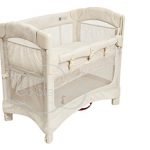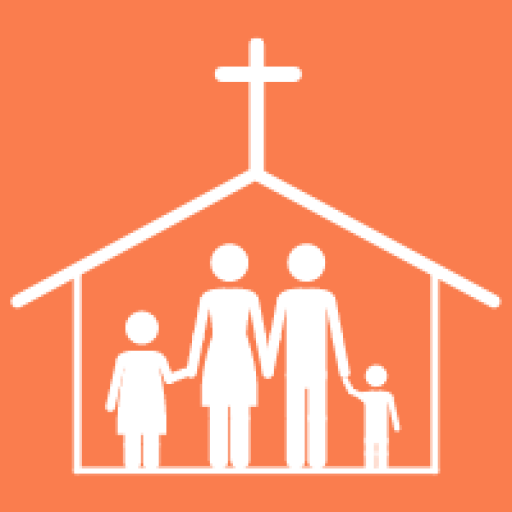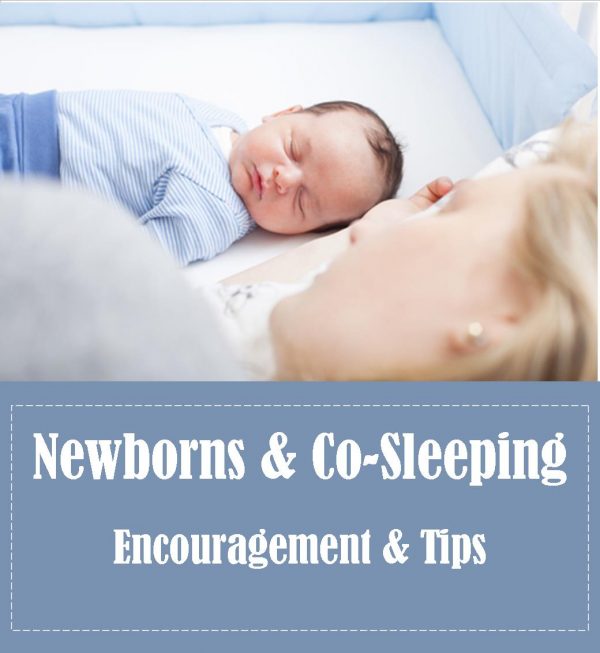“People who say they sleep like babies usually don’t have them.” Leo J. Burke
Issues of sleep are usually a top concern of expectant and new parents. Most parents aren’t really worried about daytime infant sleep (“naps”). It’s nighttime sleep (or lack thereof) they think about. Read about. Talk about. Dream about!
Newborns have an intense need for physical closeness, predictable comforting, and a sense of safety. And they can’t go long before they get hungry, so they wake up a lot, at least in the first months of life. Responding to these needs during the night when our own bodies crave sleep can really stretch us physically and emotionally.
For me, sleeping near my babies honestly helped me through the first months after baby’s arrival. Co-sleeping helped my babies and me sleep better and for longer, so that I had a little more energy during the day.
The Benefits of Co-Sleeping
Some form of co-sleeping can be helpful in helping your baby regulate his sleep. Dr. James McKenna, a prominent sleep researcher at the University of Notre Dame, reviews research in physiology, infant neurology, and human sleep, and he also conducts controlled experiments on mother-infant pairs in a sleep laboratory. He has discovered that co-sleeping moms and infants are extraordinarily in sync, responding to one another’s movements and sounds. He is unequivocal in his recommendation that babies sleep next to mom, either in the bed (if done safely) or right next to her on a separate surface, because this is the optimal sleep environment for infants:
[I]rrepressible (ancient) neurologically-based infant responses to maternal smells, movements and touch altogether reduce infant crying while positively regulating infant breathing, body temperature, absorption of calories, stress hormone levels, immune status, and oxygenation. In short . . cosleeping (whether on the same surface or not) facilitates positive clinical changes including more infant sleep and seems to make, well, babies happy. In other words, unless practiced dangerously, sleeping next to mother is good for infants. The reason why it occurs is because… it is supposed to. James McKenna in Co-Sleeping and Biological Imperatives
By sleeping with baby within arm’s reach, mom can respond to baby’s cues very easily. Baby and mom both sleep better, and baby is fed when he needs to be fed. Best of all, the baby’s breathing and body temperature become regulated in response to the mother’s physical proximity. For this reason, Dr. McKenna thinks co-sleeping can actually be safer than solitary sleep for an infant.
No, You Aren’t a Weirdo
Philip and I co-slept in some form with all of our babies, and long past baby-hood if they needed it. A few of our relatives did not approve. They even thought we were a little strange.
Believe it or not, the field of ethnopediatrics has demonstrated in several cross-cultural studies that sleeping with your baby is actually the norm if one considers worldwide practices. Meredith Small makes this argument in her book, Our Babies, Ourselves. While babies sleep in a variety of containers and on differing sleep surfaces, in almost all cultures babies sleep with an adult, and older children sleep with an adult or other siblings. Americans stand out as odd in our practice of isolating infants in sleep.
Why is it so important to us that tiny infants be independent? They aren’t leaving for college for many years! Let them be who they are: babies in need of assurance and comfort. We can’t force independence and maturity on a small baby, anyway. By responding to a baby’s nighttime cues for food, comfort, and warmth, she will become confident that she’s safe and cherished, and this leads naturally to peaceful independence. This phase will pass into a new one, and you’ll look back and be glad you gave her what she needed for those few months.
Helping Baby Sleep Longer Between Feeds
Sleep deprivation is a difficult cross to bear. I don’t generally like the idea of “sleep training,” but people mean different things by that term. I think the research is clear that the cry-it-out method is bad for babies. It can impact their brain development and their capacity for secure attachment to their parents. But if sleep training means we encourage longer stretches between waking, I’m all for it.
Elizabeth Pantley has a book on helping newborns sleep longer and a separate book for older babies and toddlers. These books are full of great ideas for helping babies sleep better and safely – all without letting your baby cry it out. Pantley’s approach involves responding to the baby’s cues, but also helping the baby learn to fall back to sleep when she reaches her natural arousal states during the night.
I found having a nighttime routine that differed from our daytime routine to be very helpful in the early months. Keep the room darkened and quiet while you are settling down with your baby for the night. Skip the light up music mobiles! Put your baby to bed when he shows that he is tired (looking away, losing interest in interacting). If we wait until the baby is over-tired, he will become cranky and actually have a harder time falling to sleep.
When your baby wakes up in the middle of the night, don’t turn on the lights (which is possible, if you are sleeping next to her) and try not to talk. You are giving your baby the signal that it’s quiet time. Babies don’t always need to be fed when they stir at night. Sometimes they just need to be comforted back to sleep. I made the mistake of trying to feed one of my babies every time he merely stirred because I thought he must be hungry. I realized that I could just rub his back and help him fall back to sleep. It took all of 30 seconds.
These practices will help your baby gradually transition to a night-day sleeping schedule. But we have to have realistic expectations. Newborns aren’t supposed to sleep through the night, and they won’t. But we can encourage longer sleep.
Safe Bed-Sharing
A few words about bed-sharing. Bed-sharing parents are frequently on the receiving end of a finger-waving warning about SIDS, or Sudden Infant Death Syndrome, the sudden unexplained death of a child younger than one year old. While SIDS is not well-understood, these deaths are believed to be correlated to the immaturity of a baby’s heartbeat, breathing, and blood pressure during sleep. Many people believe letting a baby sleep in bed with a parent increases the risk of SIDS, but the countries with the highest rates of bed-sharing experience the lowest rates of SIDS.
I have a friend who fell asleep while nursing her baby in a chair in the middle of the night. The baby rolled off her lap onto a hardwood floor. Because she tended to fall asleep in the chair, she realized it wasn’t a safe place for her to night parent her baby. We all have to know ourselves and our limitations so that we can parent wisely. I’m not trying to convince you to bed-share; I’m just trying to assuage your fears if you wish to do so. As long as you know you can bed-share safely, it’s a great choice!
If you are suffering from severe sleep deprivation, or you know you can’t nurse your baby in a chair without falling asleep, or you just want to try bed-sharing, here are some safety tips.
Do:
- Your mattress should be firm and non-quilted. Sheets should fit tightly around your mattress.
- Minimize pillows and blankets.
- Never allow a baby’s head to be covered by a thick blanket or comforter. For extra safety, I never used my own blanket for my baby at night; I would put a baby blanket on the baby and I’d have a separate blanket for myself. My pillow was flat and not very fluffy.
- Don’t position baby in between two people. If both parents are sleeping in the bed, have mom sleep in the middle.
- Newborns should sleep on their backs, not their sides or stomachs. (This is the most recent recommendation. With my first 3 babies, I was told to put my newborns to sleep on their sides.)
Don’t:
- Don’t bed-share with a newborn with other older children in the bed.
- Don’t bed-share with a newborn if you or somebody else in your household smokes.
- Don’t bed-share if your vigilance is impaired by drugs, alcohol, or exhaustion.
- Don’t bed-share with a newborn on a waterbed, sofa, or a reclining chair.
- Premature infants shouldn’t bed-share.
Floor mattress: If you’re concerned about your baby falling out of bed, you can put your mattress on the floor or use a mesh rail on baby’s side of the bed. Futon mattresses are ideal for bed sharing. I have a friend who bed-shared with her sons for years by leaving a futon mattress on the floor rather than up on a frame.
Bed on a bed: I had a little “pod” like this one for my son Dominic when he was a newborn. He had his own little bed sitting on top of my bed, so that nobody could roll on top of him.
For even more tips, James McKenna has a whole book on sleeping safely with your baby.
Again, my goal is to offer support to parents who want to try bed-sharing safely; I am not trying to convince anybody to bed-share. I am a very light sleeper; I wake up even when somebody bumps our bed. And I enjoyed sleeping next to my babies. But I wouldn’t want any mom to do something that scares her. Every mom wants what is best for her baby, and people have different comfort levels with co-sleeping. If I were a deep sleeper or I couldn’t sleep well with my baby in the bed, I would not have done it.
Co-Sleeping Without Bed-Sharing
 If you’re at all concerned about SIDS or safety, you can still sleep close to your baby with a co-sleeper, which will allow you to sleep next to your baby but with the baby on a separate sleeping surface.
If you’re at all concerned about SIDS or safety, you can still sleep close to your baby with a co-sleeper, which will allow you to sleep next to your baby but with the baby on a separate sleeping surface.
I had bassinets with my first 3 babies. I would park them right next to my bed. They were fine, but I much preferred the awesome Arm’s Reach Co-Sleeper that I had for my youngest daughter Lydia. The co-sleeper could be placed right next to our bed so that although Lydia was on a separate sleep surface I felt like she was right next to me. With the bassinets I always had to get up and put my legs over the side of the bed to lift the babies out if I needed to nurse them. The co-sleeper was much more convenient. The side of the sleeper could be lowered so that the baby was easier to reach at night; then the side could be raised up during the day.
Co-sleeping didn’t mean I wasn’t affected by lack of sleep. I was still tired; on some days it was pretty hard. But co-sleeping definitely helped me get more sleep, and it allowed me to parent my babies more responsively at night. I learned other ways to improve my well-being during those early months. I went to bed very early with the baby so that I would get more total sleep during the night than if I went to bed at my usual bed time. So I would go to bed at 8 instead of 11. Philip helped me with the other children at bedtime and during the night. But co-sleeping was the single most powerful factor in my ability to cope well in those first months after bringing home a new baby.
While these sleep choices are counter-cultural in the United States, they do not run counter to the Catholic culture of self-donative love. We can participate in the self-gift of Christ in the way we parent at night. For me, co-sleeping has been part of that self-gifting; it has become an extension of my faith.
Co-sleeping infant photo credit: Tiagoz (Dreamstime.com)

